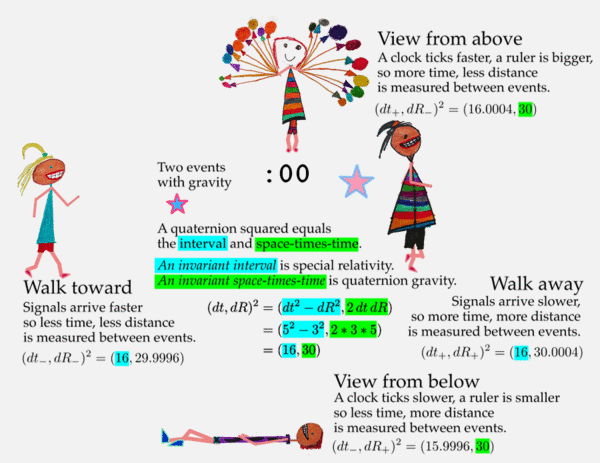SR + QG - Special Relativity and Quaternion Gravity
This graphic says a lot.
Start with the reference square which has an interval of 16 and a space-times time of 30.
Compare the reference square with the walkers. They all measure the same value for the interval of 16 because they are in the equivalence class for inertial observers, folks moving at a constant speed compared to the reference.
Compare the reference square with the girl above and boy below. Because they are in a gravitational field, they are not inertial observers. The quaternion gravity proposal says the space-times-time value are exactly the same at 30. The space-times-times being equal defines a different equivalence class. One consequences of having the space-times-time equivalent is that the intervals must be different.
If one compares a walker to one of the kids above or below, there is no overlap between the squares they calculate. One must compare the squares with the reference observer.
Page-cast
A brief explantion of this page.
For nerds
Since there is a gravitational field everywhere, there are no inertial observers. Working with the squares of quaternions, things are a little easier. Just compare the reference square with any other square. For the walkers, since they travel at a constant speed and are at the same location in the gravitational field as the reference square, they will have the same interval.
The kids above and below are not moving compared to the reference square. By the quaternion gravity proposal, the space-times-time being equal defines an equivalence class. All agree on the value of 30. What then has to be different is the interval. But how different, and how does that depend on the gravitational source mass?
Fortunately, there is no choice in answering the question if one is to be consistent with current experimental tests of gravity. For a spherically symmetric, non-rotating, uncharged source, gravity depends on the ratio of the gravitational source mass over the distance to the center of that mass. Whatever function is used to make the time measurement smaller must be the exact inverse of the one that makes a spatial measurement larger. Since gravitational systems follow simple harmonic patterns for billions of years, an exponential and its inverse that depends on the M/R ratio is an obvious thing to propose.

The interval looks just like the Rosen bi-metric proposal, even though quaternion gravity uses no metrics. The Rosen metric is known to be consistent with current tests of weak field gravity up to first-order Parametrized Post-Newtonian accuracy. The extra metric creates a problem for Rosen's proposal since gravity waves would have a dipole moment and lose energy faster than observed. The simplicity of the quaternion gravity proposal would require for an isolated mass in space that the lowest mode of emission is a quadrapole, consistent with what is seen. Yet there is no graviton with quaternion gravity.
My entry to the 2015 Awards for Essays on Gravitation is a more formal presentation of this research effort, available as a pdf.

